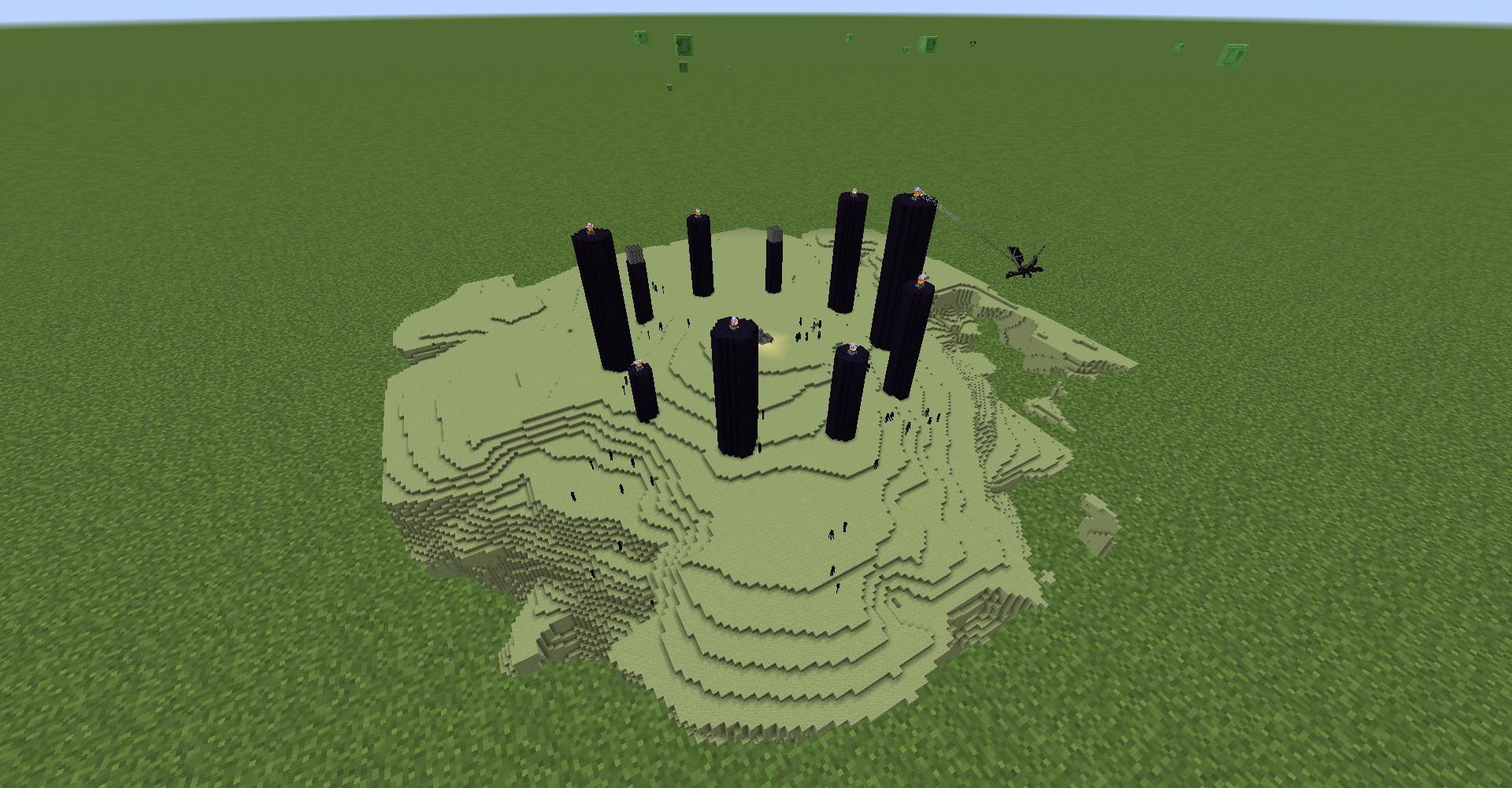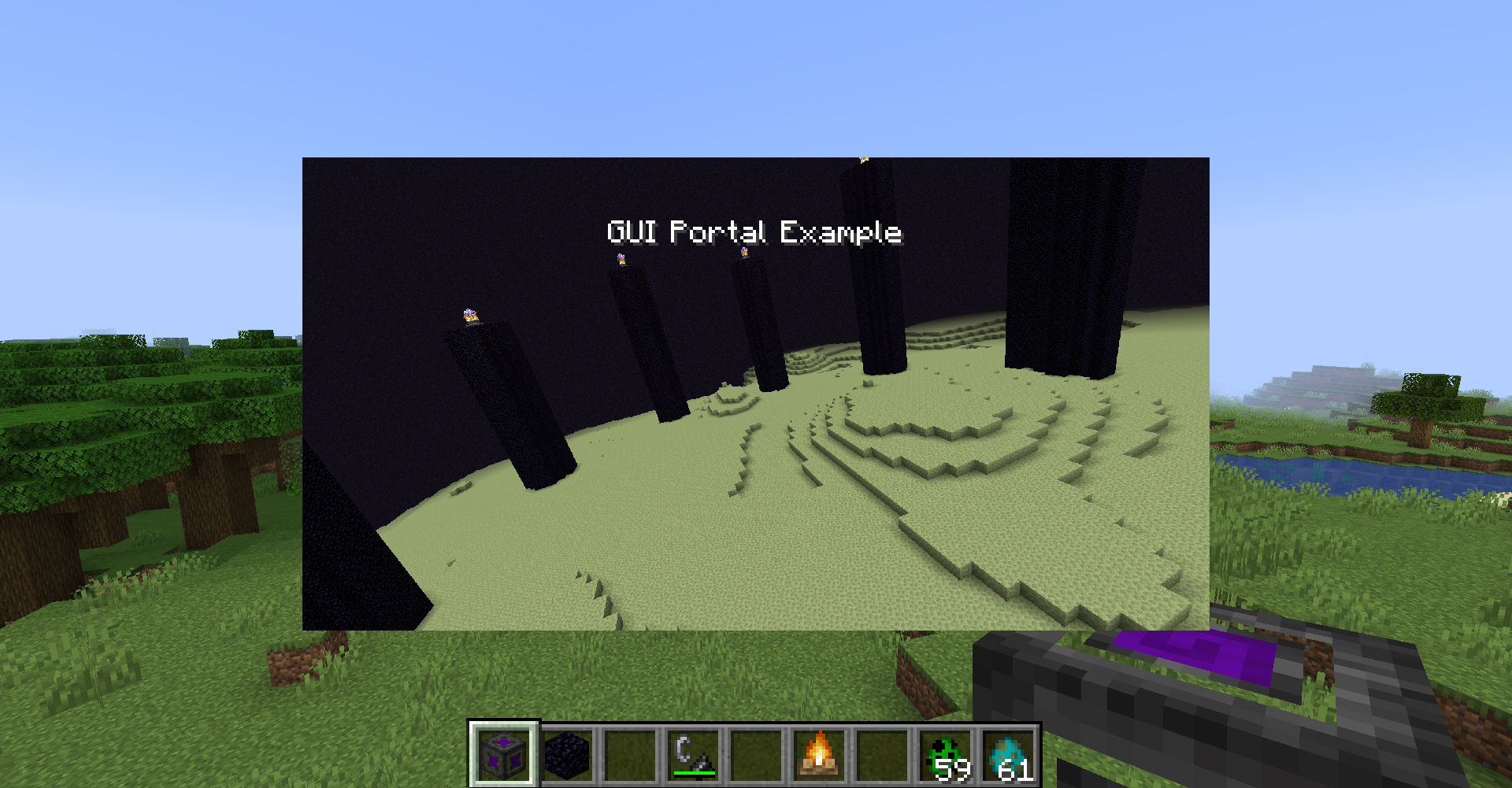-
Notifications
You must be signed in to change notification settings - Fork 113
Commands Reference
Not only the ones with level 2 permission, but any creative mode players can also use the portal targeted commands.
The portal targeted commands all targets to one portal entity. If the command sender is a player, it targets the portal that the player is looking at. If the command sender is a portal entity, the command will target that portal entity.
These commands don't work with global portals.
Change a portal entity's destination to a specific dimension and a specific position.
Set the portal destination to an entity's position.
Move the portal's destination along the direction that you are looking at.
Move the portal's destination by a vector in the other side's coordinate.
Set the portal's NBT data. Portal NBT Data Format
View the portal's NBT data.
Remove the portal.
Move the portal along the direction that you are looking at.
Change the portal's position.
Move the portal by a vector in the portal orientation coordinate. For example, /portal relatively_move_portal 1 2 3 will move the portal 1 block along axisW, 2 blocks along axisH and 3 blocks along the normal.
How this mod manage bi-way and bi-faced portals
Create a new portal entity to make the portal bi-way. Duplicated portals will be removed.
Create a new portal entity to make the portal bi-faced. Duplicated portals will be removed.
Create new portal entities to make the portal bi-way and bi-faced. Duplicated portals will be removed.
Remove portal entities to make the portal one-way and one-faced.
Completely remove a bi-way portal (4 portal entities). Equivalent to /portal remove_connected_portals and then /portal delete_portal
Set the portal's rotation transformation.
The rotation transformation is defined by a rotating axis vector and the angle in degrees. When the axis is pointing on you, a positive angle corresponds to rotating counter-clockwise.
Does not rotate the portal itself.
Similar to the above but use x, y or z to represent the axis vector
Rotate the portal. This command does not change the portal's rotating transformation.
Similar to the above.
Change the portal's rotation transformation by applying an additional rotation to the original rotation.
Similar to the above.
Set the portal's scale transformation.
Multiply the portal's scale by a number.
Divide the portal's scale by a number.
Make the portal entity only accessible by one player.
Make the portal entity accessible to all players.
This command modifies the portal cluster. It firstly removes the portals that are specific to the player and then adds new portals that are specific to the player and point to the specified dimension and position. isBiFaced and isBiWay respectively controls whether the generated portal is bi-faced and bi-way.
Remove the player-specific portal from the portal cluster.
Set a portal entity's custom name. The custom name can be used for selecting the portal entity (for example @e[name="xxx"]).
Make the portal entity's shape to be an ellipse. If the portal's width equals height, the shape will be round.
Resets the portal orientation.
Automatically adjust the portal size and position to fit a square frame. Can handle the frames that is not aligned with blocks (for example, fence blocks and end rod blocks).
Remove the portal's custom shape, making it square and set its width and height.
The global portal commands require level 2 permission.
Can only be used by a player. Converts the global portal instance that you are pointing to into a normal portal. Requires the player to be near the portal center.
Can only be used by a player. Converts the normal portal entity that you are pointing to into a global portal.
Delete the global portal that you are pointing to.
Create an inward wrapping zone. The created portals are global portals. The two XZ coordinates define the wrapping area. The generated portals go from y level 0 to y level 256.
Similar to the above but creates an outward wrapping zone.
Remove the global portal wrapping zone that you are in. This does not work for the wrapping zone constituted by normal portals.
View the wrapping zones in the current dimension and know their ids.
Remove a global portal wrapping zone by its id.
Creates a global portal that connects dimensionA 's floor with dimensionB 's top. It only generates one one-way global portal instance.
Creates a global portal that connects dimensionA 's ceiling with dimensionB 's bottom. It only generates one one-way global portal instance.
Remove the floor connection portal in that dimension. This command only removes one global portal instance.
Remove the ceil connection portal in that dimension. This command only removes one global portal instance.
Can be used by level-2 permission ones and creative mode players.
Create a new portal coming off of the side of the block you're pointing at. The portal will face towards you.
Create a portal whiches destination is distance blocks in front of the portal.
Create a small inward wrapping zone. The generated portals are normal portals. (The global portal commands does not affect them.)
Similar to the above but the wrapping zone is outward.
/portal create_scaled_box_view <x1> <y1> <z1> <x2> <y2> <z2> <scale> <placeTargetEntity> <isBiWay> [teleportChangesScale]
Note: MiniScaled mod allows creating scale boxes easily.
Create a scaled box wrapping zone. <x1> <y1> <z1> <x2> <y2> <z2> defines the inner box area. <placeTargetEntity> defines the outer box position. If isBiWay is true, it will generate the reverse portals for every portal. teleportChangesScale defines the generated portal's teleportChangesScale attribute.
The command sender dimension is the dimension of the view box. For example, if you want to create a box viewing the end island, use /execute in minecraft:the_end run portal create_scaled_box_view -100 0 -100 100 128 100 20 @p true
(-100 0 -100 100 128 100 is a box with radius 100 on the end dimension, 20 is the scale, the outer box will be placed on @p 's position)
Note: MiniScaled mod allows creating scale boxes easily.
Similar to the above but the created scale box has better rendering performance.
The outer portals will have "fuse view" enabled and "rendering mergable" enabled.
The inner portals will have "rendering mergable" enabled.
The portals will have "teleport changes scale" disabled.
This command requires that the scale box area is either aligned to chunk border (Press F3+G to see the chunk border) or does not have anything around that area (for example, a skyland). Because the merged portal rendering does not handle the front clipping well, if this requirement is not meet, the things outside the box may appear in view.
Create a portal entity that goes from fromEntity to toEntity. The portal's orientation is determined by fromEntity 's orientation.
Create some rooms near you and generate portals to connect these rooms. The rooms will be made by random blocks. For example /portal create_connected_room roomSize 8 8 5 roomNumber 10
Can be used by creative mode players and permission 2 ones.
Teleport you across dimensions without any loading screen. Can only be invoked by players.
Teleport entities across dimensions.
Sometimes you went into a one-way portal and want to come back, but you forgot the coordinate where you come in. Use this command to come back.
By specifying 2 portal entities, it will change these 2 portals' destination and rotation transformation to make them connect.
Shows a GUI that allows re-configuring the dimension stack.
These commands are provided by mod q_misc_util (this mod is bundled by Immersive Portals).
Dynamically add a new dimension. That new dimension's dimension type and chunk generator will be the same as the templateDimension. If you provide the argument newSeed, then the new dimension will be in another seed. It's possible to clone other mod's dimensions.
This command only clones the dimension type and world generator. It will not clone the things in world (blocks, entities, ...).
Example: /dims clone_dimension minecraft:overworld "aaa:bbb" will dynamically add dimension aaa:bbb whiches world generation is the same as the overworld.
The configuration of the new dimensions will be saved in the q_dimension_configs folder in the world saving.
Dynamically remove a dimension.
This command will not delete the world saving of that dimension. If you re-add that dimension, its blocks and entities will still be there.
Can be used by creative mode players and permission 2 ones.
Load the chunks near the specific position and display a GUI portal for the player. Used for testing GUI portal functionality.
For example, /portal debug gui_portal minecraft:the_end 0 80 0
Press ESC to quit.
Enable the experimental isometric view for the player. viewHeight is the corresponding length of the screen height.
For example, /portal debug isometric_enable 100
Isometric view is implemented by replacing the projection matrix with the orthogonal projection matrix. Isometric view equivalents the camera being in an infinitely far place.
Quit the isometric view for the player.
Align the player position by 0.5, set the yaw to be 45 degrees and set the pitch to be 30 degrees. Can be used for taking isometric screenshots.
Creates a command stick . For example /portal debug create_command_stick "/say hi"
This command requires level 2 permission.
Accelerate the player along the view direction. This is originally used for debugging collision issue, and then turns out to be useful for travelling.
Erase the blocks of the chunks near you. Can be used for checking dimension stack status. Requires level 3 permission.
Call System.gc() and show the memory usage. Requires level 4 permission.
Note: The memory usage is influenced by many random factors. To test whether it has a memory leak, you should run the game for at least 5 minutes.
Show chunk loading numbers.
Show the player's current dimension, position and entity status both on client side and server side.
Shows if the chunk is loaded in your current dimension on client side and server side.
Report the chunk loaders originated by you.


